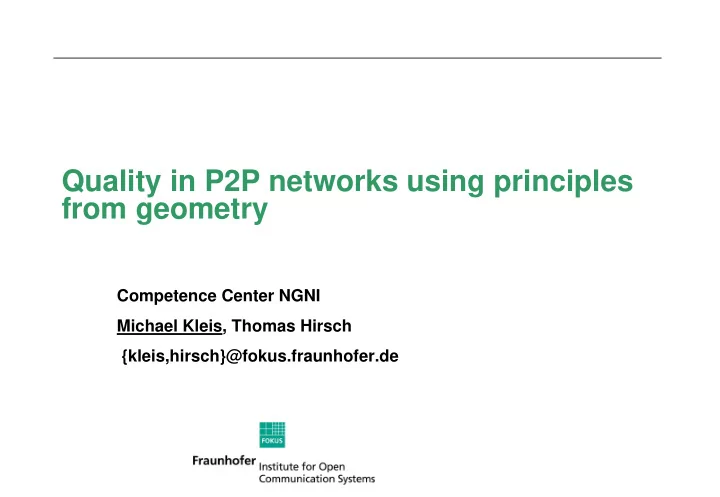

Quality in P2P networks using principles from geometry Competence Center NGNI Michael Kleis, Thomas Hirsch {kleis,hirsch}@fokus.fraunhofer.de
Overview � Challenges in P2P Networks � Geometric models and P2P Networks � Mapping Functions � Service Specific Metrics � Service/Network aware optimisation of P2P Network Topology � Pathological Cases and Problems � Future Work
P2P/Overlay Networks Challenges: � P2P Network Topology: � Quality/Performance. � Scalability, distributed algorithms for management. � Routing (requests/data) should be “simple” and efficient. � Avoid partitioning of P2P Network (nodes join/leave dynamic). � Quality, Service/Network aware optimisation of P2P Network: � Definition of service specific metrics for optimisation (e.g. “loss”, “delay”, “jitter” and/or “server load” in case of streaming). � Keep system performing over time. � Avoid “much” measurement overhead.
Geometric Topologies for P2P Networks Advantages: � Rich repository from Geometry available (CAN, Delaunay Triangulation, Voronoi Diagrams, HyperCubes). � Routing can be based on “structure” (e.g. Compass Routing and Delaunay Triangulations). � Proximity detection “easy” (e.g. Voronoi Diagrams). Challenges: � Mapping function for assigning “meaningful” geometric coordinates to a node needed. � Mapping Trade-off: Scalability vs. Accuracy. � How to keep the coordinate of a node meaningful over time ?
Geometric Topologies: Content Addressable Network (CAN) Sylvia Ratnasamy, Paul Francis, Mark Handley, Richard Karp, Scott Shenker „A Scalable Content-Addressable Network“, Proceedings ACM SIGCOMM 2001
D: (x_d,y_d) Compass Routing in CANs S: (x_s,y_s)
Geometric Topologies: Voronoi Diagrams/Delaunay Triangulations Voronoi Diagrams for organisation of Nodes in Overlay/P2P Network: Routing: “Compass Routing”. Broadcast: “Reverse Path Forwarding”. Proximity detection: “easy” (Voronoi Diagram represents solution of “post office problem”). Resilience: Neighbour relationship represents Delaunay Triangulation. Distributed algorithms for management and recovery of node failures possible. Jörg Liebeherr, Michael Nahas, Weiheng Si, Application -Layer Multicasting with Delaunay Triangulation Overlays (2001) http://citeseer.nj.nec.com/liebeherr01applicationlayer.html
Delaunay Triangulation/Voronoi Diagrams Destination Forward Compass Routing: β α Source
Mapping Functions: GNP Global Network Positioning (GNP) (by T.S. Eugene Ng and Hui Zhang) y Joining Node Landmarks and GPS principle for calculation of coordinates. Heuristic used: Triangle inequality is valid in networks. Measurement Landmark 1 Landmark 3 Number of landmarks can be constant (i.e. constant measurement complexity) x Service/Network aware optimisation: •Measurement used by landmarks has to reflect service requirements. Landmark 2 •Nodes that have equal properties regarding the service specific metric are „near“ in the geometric representation.
Mapping Functions: IDMaps � Target: Nearest Mirror selection Problem. � Internet-wide infrastructure to collect distance information. � Distance metrics: hop count, round-trip time, minimum bandwidth. � Provides: long-term approximate distances, distance estimation between any two points on the Internet. � Does not provide: end-to-end application level performance, available bandwidth or current delay, characteristics of any “specific path”. � IDMaps: � Tracer Infrastructure. � All hosts in an Address Prefix region are considered to be equidistant from the rest of the Internet. � Tracers measure distance between themselves and to APs -> Distance Map.
Service Specific Metrics and Quality in P2P Networks � Aim: Use Geometric Topology and mapping function to optimise P2P/Overlay Network for Service Requirements. � Interconnect nodes that are “near” in the geometric representation of the Network. � Measurement used by mapping function for canonical optimisation: � Bandwidth: Packet Pair Method, Active Measurement. � Delay: Round Trip Time. � Loss: Hop Count (heuristic). � Application specific Metrics (load of system etc.). � In the case of multiple requirements: � Every node may have multiple “identities” in the P2P Network.
Service Aware Optimisation of P2P Network using Proximity Detection Landmark System P2P Network (2) Measure request Bootstrap Node(s) (3) Measurement (5) Join Response (4) Calculate Coordinate (1) Join Request (6) Join Procedure P2P Node Overlay Link Coordinate
Pathological Cases and Problems � Placement of landmarks is critical to the quality of resulting P2P/Overlay Network. � Measurement used for placement is just a snapshot of the situation in the Network -> replacement strategy needed. � Replacement changes node coordinate -> update of directory service or name service needed. � Organisation of nodes in hierarchical (multi layer) topologies: � Leader election algorithms for choosing “local” Leader. � “local” Leader serves as router for long-distance communication. � Security !
Current Simulation Environment (DGON) � Written in java. � Imports Network Topologies generated by BRITE � Implements FARA. � GNP used for placement. � Triangulation/Voronoi Diagram based. � Compass Routing. � Dimensions > 2 possible. � Fully distributed. Clark, D., Braden, R., Falk, A., and Pingali, V., "FARA: Reorganizing the Addressing Architecture". ACM SIGCOMM 2003 FDNA Workshop, Karlsruhe, August 2003 . BRITE: http://www.cs.bu.edu/brite/index.html
Current Simulation Environment
Overlay/P2P Networks for information distribution Application-layer Multicast for distribution services on top of content delivery networks - CDN, or P2P systems. Advantages: � Error control (ARQ, FEC) and congestion control can be based on unicast solutions (e.g. in the case of streaming). � Broadcast/Multicast services possible without IP Multicast infrastructure. � Streaming content can be tailored to client / user (transcoding, targeted advertising etc.) Disadvantages: � Reduced efficiency compared to IP-Multicast (redundant traffic on physical links).
Application Layer Multicast Possible Platform for: � Broadcast of streaming data. � Event notification. � Policy distribution. � Online gaming.
Future Work � Keep the P2P/Overlay Network performing over time. � Include FARA addressing and hierarchical approach. � More simulation and measurements ! � Implementation of prototype.
Thank you for your Attention ! Questions ?
Recommend
More recommend